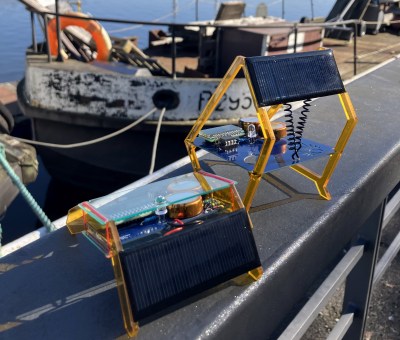With all those e-paper based projects doing the rounds these days, including in our Low Power Challenge, you’d almost forget that monochrome LCDs were the original ultra-low-power display. Without them, we wouldn’t have had watches, calculators and handheld games operating off button cell batteries or tiny solar panels back in the ’80s and ’90s. [Gabor] decided to build a set of gadgets with a 1990s LCD aesthetic, called LCD Solar Creatures. These cute little beasts live on nothing but solar power and provide some amusing animations on a classic seven-segment LCD screen.
The Creatures’ activity depends entirely on the amount of power that’s available to them. If their supercapacitors dip below 3.3 V, their micros enter a deep sleep state and do nothing except briefly flash an LED every now and then as a sign of life. When light hits the solar panel, the supercaps are charged up and the Creatures come to life and display a few basic stats. Once the caps hit 4.1 V, they really start their day and run a few programs, including a Game of Life-style simulation and an animation of Euclidean rhythms.

Even in active mode, the complete system uses just 11.4 micro-amps – enough to run completely off the 30×70 mm2 solar panel. The charge circuitry is deliberately kept as simple as possible with just a pair of diodes to prevent the solar panel from overcharging the caps in bright light or discharging them in darkness. The ATtiny85 that runs the show is powered through a 3.3 V LDO and measures the capacitors’ voltage through a 1 MOhm resistive divider.
The Creatures’ bodies are made from pieces of laser-cut acrylic, further adding to the 1990s vibe. Monochrome LCDs might seem old-fashioned, but they’re perfect for low-power projects like this, or, say, making your own wristwatch. Nowadays you can even design your own LCDs and have them professionally made.


















Those solar led garden spikes seem like a good doner for a power supply. If coupled with a super capacitor, they could be charged relatively quickly. They can charge a relatively low capacity AA size cell. But daisy chaining a few together isn’t too tricky. The only thing is, sometimes they put out pulsed DC or AC.
Some flashing led dog collars use super capacitors for the power supply, although they are usually charged via USB.
I like to repurpose rather than buy off the shelf wherever possible.
I think that the linear regulator does not make any good sense here. Instead of burning the power in the micro @5V, here it burns less power @3.3V and the regulator burns the rest + his own inefficiency and Iq. A carefully designed buck-boost circuit could be more beneficial here.
I agree but I would say a linear regulator with lower Iq and dropout would be a better choice instead of a buck boost regulator. In my experience for low power applications the quiescent current of decent linear regulator is often better than the quiescent current of buck boost regulators.
That said, this particular circuit is hardly “low power” with its ATTiny part.
For the current consumption here (in µA), the drop in the regulator is nothing (4.1V to 3.3V multiplied by 10µA is 8µW. I doubt you can get a smaller loss from a DC/DC regulator.
There’s no need for a regulator in this application, it’s just a waste of money and energy. The ATtiny85 has a guaranteed working voltage range of 2.7…5.5V and the HT1621 will be happy with 2.4…5.2V. If you’re brave, you can even ditch the 5.2V zener and burn excess voltage with software.
btw, measuring Vcc can be done without external components and using an IO pin, just set ADC reference to Vcc, input to Vbg and do the math.
I had seen that supercaps voltage more than half their max rating leak horribly (5F leaks @ 15mA @ 2.3v). So yeah…, a very small rechargeable cell with low leakage would do better, the circuit doesn’t even need to sleep ;)
“Creatures” is the wrong word here. To call them “creatures” they’d need to actually move, but I suspect there wouldn’t be much hope of running even the lowest powered of DC (or other or unconventional type) motors from this panel and supercap power source.
Since when do creatures have to move?